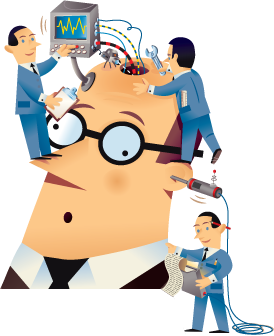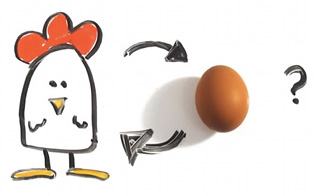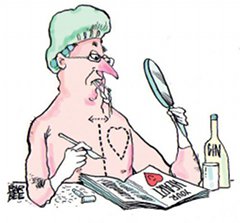The following question came from a mom whose daughter is being treated for congenital strabismus (an eye turn since birth).
Mom has been reading Sue Barry’s book, Fixing My Gaze, and presented the following, excellent question:
If we are all born with binocular neurons (nature instead of nurture), why do some people with congenital strabismus achieve full binocular vision with VT, while others do not?
Sue Barry compares the success rate for developing stereopsis between those who are treated with surgery and those treated with optometric vision therapy:
Only 20% of patients with infantile strabismus who have surgery after the age of two years develop stereopsis. In contrast, 38-50% of patients with infantile strabismus …. acquire stereopsis through optometric vision therapy.
Mom goes on to wonder:
My interpretation, as a layman, is that apparently there are some factors contributing to ‘success’ and factors diminishing it. Anyone?
Below, I present some of the factors which complicate the successful remediation of strabismus with optometric vision therapy:
 Hardware vs Software
Hardware vs Software
I think it may be helpful to consider the disconnect between the aim of the eyes and the potential of the brain as a difference between hardware and software.
If the software (brain) is fully capable of binocular vision in everyone, but the hardware (eyes) are installed in a posture which reduces the opportunities for simultaneous firing of binocular cells, some of us end up with a predisposition to use the eyes in a monocularly-favored or asymmetric way.
HOWEVER… the binocular software (i.e., stereo-processing in the brain) remains available.
Meanwhile, these children make use of their turned-eye hardware “as is.” They are using equipment with limitations, and they develop behavior patterns around these limitations.
- Some of them find it disconcerting, and reduce their reliance upon vision as a source of information.
- They tune into other senses (auditory, tactile) rather than struggling to hone vision.

Chicken-and-egg
Most parents of more than one child are quick to agree that children are born with different innate personalities/ tendencies. It is not just a matter of nurture. Nature is a factor.
But with a given nature, some conditions become harder to nurture…
In some children, an early surgery can result in a successful re-alignment … and progress in visual development follows. Whereas in others (particularly detail-oriented people), it is not natural for them to go on to develop attention over a larger area. So FUNCTIONALLY, they under-utilize their peripheral vision.
There is a bit of a chicken-and-egg problem at play here: An underlying eye-turn encourages suppression of visual information, resulting in a reduction of attention to the periphery. But it is the simultaneous use of the retinal periphery which supports binocular development.
Use of the retinal periphery is the BASIS for localization, orientation, and depth perception. Without these skills, a person takes on a “tunnel-vision” tendency, reconstructing the visual forest by getting to know every tree. Again, chicken-and-egg.
Adapting to Strabismus
Some patients with strabismus make good adaptations. They develop anomalous projection, so that they enjoy a modified form of binocular seeing, even with their eyes in the turned posture. They find a healthy way to use one eye as a lead and the other as a support (just like writing with the right hand and holding the paper still with the left).
Some patients alternate eyes based on viewing distance: One eye leads/ the other supports for distance viewing… and the lead/support roles reverse for near-point viewing. In many of these folks, the mid-range causes the most confusion.
More symptomatic patients lack such supportive adaptations, and may have complaints of constant instability of their visual world. They may freely, even uncontrollably alternate aim between the two eyes. When reading, they are likely to skip around on a page, or read letters out of order on a chart. They use a finger or a marker to keep their place when reading, and they may subvocalize words to keep themselves on track.
Human Factors
Ultimately, when considering the percent success rate cited above, it is important to allow for human factors. The person involved in the therapy needs to be motivated and actively engaged for a successful outcome. And they need to allow a therapy process to occur.
At the same time, the doctor (therapist)-patient relationship needs to facilitate the process, with clear communication, and a clear plan mapping the way towards success. There is no shortage of vision therapy activities available. The art of a successful therapy program is the selection of activities and learning opportunities which will be particularly therapeutic for each patient’s needs.
Home-based Therapy for Strabismus?
One more word which relates to the success rates you mention, and which should be factored in:
Strabismus is a Do-it-Yourself (DIY) solution to a binocular vision problem.
As such, it truly requires guided intervention for a different result.

Some of the patients that I, as a doc, find the most challenging to work with are the ones who wish to drive through their problem by sheer force, when what is needed is for them to let go and allow a more relaxed state to invite two-eye seeing and processing. Often these are patients with strabismus, often esotropia, who are convinced that the reason they have an eye turn is that they “are not working hard enough.” They are very motivated, and they wish to simply work harder to overcome the problem. The irony here is that they have to work harder at working LESS hard– they need to practice a DIFFERENT behavior, a softer way of looking, to allow room for the two lanes of visual traffic to MERGE. This is the hardest lesson to apply for a person who has great motivation, but struggles to let go of how the process can be accomplished.

I have been both a doctor and a patient in the therapy process. The “DIY” do-it-yourself approach is rife with pitfalls. The best, active therapy plan is a guided program, with specifically selected goals and activities to build supportive skills (like peripheral processing of information), and specific, suggested opportunities to practice and integrate these skills in real life.
How many psychologists does it take to change a light bulb?
Just one… but it has to realllllly want to change.
With sincere motivation, and with a willingness to allow for a therapy process to address behaviors– not just eye muscles– I believe each patient has the potential to harness their innate binocular software for a successful outcome.



Very well done, Dr. Slotnick! Love your analogies and metaphors here, which serve to lessen the confusion that many parents experience.
Thank you, Dr. Press!! I do hope that makes this challenging topic more accessible!
A well written piece. Quite understandable. The idea that the area the patient selects to view–central versus peripheral–and the effect of this selection in response to surgery and VT is a good one.
Enjoyed this.
I am so glad; thank you, Dr. Cook!
Dr. Slotnick,
Thanks for a great and much needed blog. Will be sharing this with my patients!
Thanks, Dr. Luk! Please do!
Congratulations, Dr. Slotnick. You have a remarkable way to describe complex proceedings. Sometimes fighting is the wrong way and “letting loose” the better one.
All the best from Germany.
Josef Thiel, Behavioral Optometrist
Many thanks, Dr. Thiel! I appreciate the feedback, and I’m so glad you find the analogies useful!
Warmest regards… from New York!
😀
-SS
This is outstanding.
Ernie
Thank you, Dr. Loewenstein!